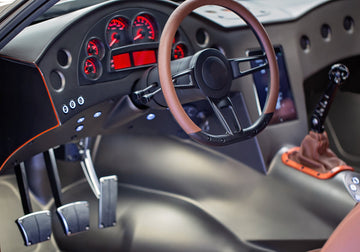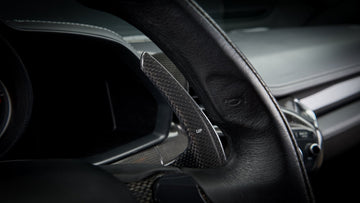Your steering wheel is the most used component in your entire vehicle, yet it's probably the most overlooked when it comes to upgrades. You interact with it more than your shifter, more than your pedals, and definitely more than any flashy exterior modification. Despite being your primary physical connection to the road, most people never consider changing it.
In actuality, steering wheel replacement has developed a reputation for being complicated and risky if done wrong. But what if the process was more straightforward than you've been led to believe, and what if upgrading this component could transform both how your interior looks and how driving feels?
Why People Replace Their Steering Wheels
Steering wheel replacements aren't just about aesthetics, although a custom wheel can dramatically elevate your interior's appearance. Many drivers swap their factory wheels for performance reasons. Aftermarket steering wheels often feature smaller diameters, which means less input is required for the same steering response. This translates to quicker, more precise handling, especially on track days.
Beyond performance, there's the comfort factor. Factory steering wheels come in one size and one shape. Custom wheels from companies like Exclusive Steering allow you to choose materials that feel better in your hands. Premium leather imported from Italy or Japan, suede for better grip, or carbon fiber for that race-inspired look and feel. Your steering wheel is something you physically interact with for the entire duration of every drive. Shouldn't it feel exactly how you want it to?
For serious track drivers with racing harnesses, the factory airbag becomes less relevant. Racing harnesses restrict body movement by design, which means you won't be moving forward to meet an airbag during impact. Many drivers choose to eliminate the airbag entirely and opt for a smaller, lighter aftermarket wheel.
The most common reasons enthusiasts upgrade their steering wheels include:
-
Performance gains through reduced diameter: Smaller wheels require less rotation for the same steering angle, improving response time and giving you more precise control during spirited driving or track sessions.
-
Personalized ergonomics and grip: Custom wheels let you choose the exact thickness, material texture, and diameter that fits your hand size and driving style perfectly.
-
Weight reduction for better feel: Aftermarket wheels are often significantly lighter than factory units, especially those with heavy airbag systems, which translates to better steering feedback.
-
Interior aesthetic transformation: A custom steering wheel serves as the centerpiece of your cockpit, instantly elevating the entire interior's visual appeal.
-
Track-focused functionality: For cars equipped with racing harnesses and roll cages, removing the bulky factory wheel creates better sightlines and more efficient cockpit ergonomics.
Understanding Compatibility and What You'll Need
You can't just bolt any custom Mustang steering wheel onto any car. Your vehicle's steering column has a specific spline pattern, and your new wheel needs to mate with it perfectly. This is where the hub adapter, sometimes called a boss kit, becomes necessary.
The hub adapter is the bridge between your car's steering column and your new aftermarket wheel. These adapters are vehicle-specific, meaning you need to know your exact year, make, and model before ordering. A hub for a 2015 Subaru WRX won't work on a 2016 model if the steering column changed. When working with Exclusive Steering, their team helps ensure you get the correct hub adapter for your specific vehicle, eliminating the guesswork.
Beyond the hub adapter, you might also want to consider a quick-release mechanism. Quick-releases allow you to remove and reinstall your steering wheel in seconds, which is helpful for theft deterrence or easier entry and exit in cars with tight cockpits. You'll also need to think about spacers if you want to adjust the wheel's position relative to the dash and your body.
|
Component |
Purpose |
Why It Matters |
|
Hub Adapter (Boss Kit) |
Connects aftermarket wheel to steering column |
Vehicle-specific; wrong adapter means the wheel won't fit |
|
Quick-Release (Optional) |
Allows tool-free wheel removal |
Adds convenience and security; requires compatible hub |
|
Spacer (Optional) |
Adjusts wheel position forward or back |
Improves ergonomics and comfort based on driver preference |
|
Horn Wiring Kit |
Maintains horn functionality |
Required for street-legal operation in most areas |
Legal and Safety Considerations You Can't Ignore
Airbags save lives, and removing them isn't a decision to take lightly. If your car came with an airbag-equipped steering wheel and you're replacing it with one that doesn't have an airbag, you need to understand the implications. First, check your local laws. Some states and countries have specific regulations about airbag removal or replacement.
If you're building a dedicated track car that never sees public roads, removing the airbag makes sense. If this is your daily driver, you need to seriously weigh whether the aesthetics and performance gains are worth the reduced safety.
Another safety consideration involves proper installation. A custom Subaru steering wheel is useless without proper installation. Worse yet, come loose during driving, which is catastrophic. This is one modification where cutting corners can have serious consequences.
Before proceeding with your steering wheel replacement, consider these critical safety factors:
-
Legal compliance in your area: Research your state or country's specific regulations regarding airbag removal and aftermarket steering wheels.
-
Vehicle usage patterns: Daily drivers with passengers carry different safety requirements than dedicated track cars.
-
Insurance implications: Contact your insurance provider to understand how removing factory safety equipment might affect your coverage.
-
Proper torque specifications: Using a torque wrench to achieve manufacturer-specified tightness isn't optional, as both under-tightening and over-tightening can create dangerous failure points.
The Step-By-Step Replacement Process
While every vehicle is slightly different, the general procedure follows a similar pattern. This is where having quality parts from Exclusive Steering makes a significant difference.
Safety First: Battery Disconnection
The first step is disconnecting your vehicle's battery. Both terminals ideally, but at minimum the negative terminal. This prevents accidental airbag deployment during the removal process. After disconnecting the battery, wait at least five to ten minutes. This allows the electrical system's capacitors to fully discharge.
Removing the Factory Wheel
Most modern wheels have the airbag module mounted in the center pad. You'll need to access the mounting bolts or clips that hold this module in place. The fasteners are often Torx bolts, so having a quality Torx bit set is helpful. Once the bolts are removed, carefully lift the airbag module away from the wheel. You'll see wiring connectors that need to be disconnected carefully. There's usually a release tab that you press while gently pulling the connector apart.
With the airbag removed and set aside in a safe location (airbag side facing up, never down), you'll see the main steering wheel mounting nut. Before removing it, make sure your wheels are pointed straight ahead and mark the position of the steering wheel relative to the column. This ensures your new wheel will be centered correctly when installed.
The Steering Wheel Puller Solution
Once the mounting nut is removed, the wheel should slide off the column. In reality, many factory wheels are pressed on quite firmly. A steering wheel puller tool is inexpensive and makes this step dramatically easier. The puller threads into the mounting bolt holes and applies even pressure to separate the wheel from the column shaft without damaging anything.
Installing Your New Setup
With the factory wheel removed, you can now install your hub adapter. The adapter must be aligned perfectly with the steering column's spline pattern. Even being one tooth off will result in a crooked steering wheel.
Thread the horn wire through the center of the hub adapter before bolting it down. The adapter typically uses the factory mounting bolt, which needs to be torqued to the manufacturer's specifications. If you don't have a torque wrench, this is a good time to invest in one.
If you're using a quick-release mechanism, it installs on top of the hub adapter using the included hardware. Then comes your new steering wheel, which bolts to either the hub adapter directly or to the quick-release mechanism.
Wiring and Final Connections
Your new wheel needs to connect to your vehicle's horn circuit, which was previously routed through the factory airbag system. Different hub adapters and wheels handle this differently. Exclusive Steering provides clear wiring instructions with their wheels, and their support team can walk you through the specifics for your vehicle if you get stuck.
Why Working With Exclusive Steering Makes the Difference
When you're modifying a critical safety system like your steering, parts quality isn't negotiable. Cheap hub adapters can fail catastrophically. Poorly constructed wheels can crack or break down after minimal use. Exclusive Steering has built their reputation over 16 years by focusing on quality, using premium materials like leather from Italy and Japan.
The customization options are another major advantage. Rather than choosing from a limited selection of pre-made designs, Exclusive Steering gives you nearly unlimited creative freedom. Want a specific leather color matched to your interior? Done. Prefer suede inserts for better grip combined with leather on the sides? No problem. Carbon fiber accents? This level of customization used to be reserved for six-figure builds, but Exclusive Steering has made it accessible to regular enthusiasts.
What sets Exclusive Steering apart from other aftermarket steering wheel suppliers:
-
Premium imported materials: Leather sourced directly from Italy and Japan ensures superior quality, durability, and feel compared to generic alternatives.
-
Unlimited design customization: Rather than forcing you to choose from preset options, Exclusive Steering works with your vision to create exactly what you want.
-
Knowledgeable enthusiast support: Their team consists of actual car enthusiasts who understand the technical aspects of steering wheel swaps.
-
Comprehensive compatibility assistance: They help you identify the exact hub adapter and components needed for your specific vehicle.
-
16 years of proven experience: Their long-standing reputation in the community speaks to consistent quality and reliability.
Common Mistakes to Avoid
The single most common mistake is improper hub adapter alignment. When installing the hub adapter, double and triple-check that it's aligned correctly with the wheels pointed straight. Some installers recommend test-fitting everything loosely first, taking the car for a short drive in a parking lot to verify the wheel is straight, and only then torquing everything to final specifications.
Another frequent error is forgetting to plan for the airbag light. When you remove a factory airbag system, your vehicle's computer knows it's missing and will illuminate the airbag warning light on your dashboard. Most hub adapter kits include a resistor that mimics the electrical load of the airbag. Make sure this resistor is installed properly according to the instructions.
The most frequent installation errors include:
-
Misaligned spline engagement: Being off by even one tooth on the spline pattern results in a permanently crooked steering wheel.
-
Skipping the waiting period after battery disconnection: Immediately working on the airbag system after disconnecting the battery doesn't allow capacitors to discharge.
-
Forgetting to mark the centered position: Failing to note where the factory wheel sits when driving straight makes it nearly impossible to install the new wheel correctly.
-
Over-tightening fasteners without a torque wrench: Guessing at proper tightness leads to either stripped threads or dangerous loosening.
-
Ignoring the airbag resistor installation: Overlooking this component results in a permanently illuminated dashboard warning light.
Testing and Final Checks
Once everything is installed and torqued to specification, give everything a thorough visual inspection. Check that all bolts are tight, all wiring connections are secure, and nothing looks out of place. Wiggle the steering wheel to ensure there's no play or looseness.
Reconnect the battery and start the vehicle. Check that the airbag light behaves as expected. Test the horn functionality by pressing the horn button or center cap. If the horn doesn't work, resist the temptation to just live without it. A functioning horn is a safety device and required by law in most places.
Take the car for a short test drive in a safe area like an empty parking lot. Verify that the steering wheel is perfectly centered when driving straight. Check to see if your steering response feels normal and there are no unusual noises or vibrations.
The Satisfaction of a Personal Touch
There's something satisfying about upgrading your steering wheel. Unlike many modifications that you look at or that passengers notice, this one is for you. Every single time you drive, you'll feel the difference. The material beneath your fingers, the perfect diameter that fits your grip, the reduced distance that improves your driving position.
With Exclusive Steering handling the quality and compatibility concerns, the installation process becomes manageable even for enthusiasts without extensive mechanical experience. Take your time, follow the steps carefully, and don't hesitate to reach out for guidance when needed. Your steering wheel stops being just a functional component and becomes a statement piece that represents your vision for your vehicle.





